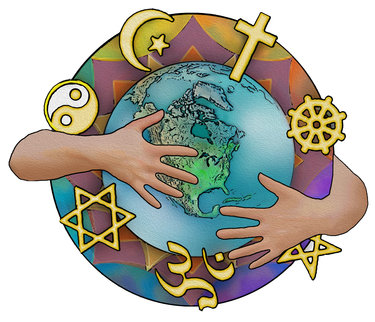Schools can lead us to embrace diversity
We believe one of the greatest strengths of our nation lies in its diversity. The United States of America was built on the contributions of peoples from around the globe.
We should not just tolerate diversity; we should embrace it.
Understanding the cultures that make up the richness of our country enriches us. We are not playing a zero-sum game here. Learning about another person’s or family’s way of life does not diminish ours. Rather, it extends our sense of common humanity.
These ideas have been kindled as we watched the two most recent virtual meetings of the Guilderland schools’ Committee on Diversity, Equity, and Inclusion. The committee members are having important and thoughtful discussions on the school calendar.
A school calendar of course has a finite number of days. Guilderland schools, like those across New York, must have 180 days in any school year. The penalty for not meeting that threshold is real and painful since state aid depends on it.
The district’s superintendent, Marie Wiles, noted that every day less than 180 would cost the district about $86,000, or a year’s salary for a teacher. Other parameters include matching schedules for regional programs and sports competitions with other schools.
While Guilderland now allows excused absences for religious holidays, Wiles wisely noted that students still feel pressure to attend, wary of missing tests or labs.
We urge teachers to be aware of students in their classes who may, for example, be fasting or missing school because of a holiday, and to be thoughtful about not assigning work on those days that would be hard to make up.
The issue has been punctuated by Muslim students at Guilderland who wrote powerful messages to the school board, advocating that the school calendar take their religious holidays into account.
Longtime school board member Judy Slack, toward the end of the Feb. 1 meeting, said she was ashamed that she had not been aware of Eid al-Fitr, which one of the students had explained marks the end of fasting for Ramadan.
“First of all, Eid is like Christmas for us,” wrote Arisha Ahmed. “Imagine having to go to school on Christmas. It is as simple as that.”
As we watched the Feb. 1 school board meeting, we had a sense of déjà vu, remembering how Guilderland went through a similar awakening more than a quarter-century ago when several board members said only federal holidays should be observed as days off from class. However, at the same time, as now, Good Friday was a school holiday, as well as days surrounding Christmas and Easter.
In the fall of 1995, several other board members expressed outrage that a teacher had tested students on Yom Kippur, the day of atonement, the most important and sacred Jewish holy day. Public and board discussions followed, resulting in the district deciding not to hold classes on the Jewish high holy days — a practice the Guilderland schools still follow.
We think it is wonderful that Guilderland is becoming an increasingly diverse community. According to the State Education Department, the Guilderland school district has 190 African-American students, or 4 percent; 181 Hispanic students, also 4 percent; 647 Asian students, or 13 percent; 3 Native American students, or 0 percent; 169 multi-racial students, or 4 percent; and 3,617 white students, or 75 percent.
We could find no tally of religious diversity in the Guilderland schools but we assume it reflects the increasing cultural diversity.
The Committee on Diversity, Equity, and Inclusion wisely consulted a list put out by the Anti-Defamation League, naming national and international holidays as well as religious observances. The list is 18 pages long.
January alone, for example, includes not just the familiar national holidays of New Year’s Day and Dr. Martin Luther King Jr. Day but also, among the dozen holidays listed, the Sikh Guru Gobind Singh Ji’s Birthday, the Armenian Orthodox Christmas, the Hindu Makar Sankranti, the Bahá’í World Religion Day, the Buddhist Mahayana New Year, and the Jewish Tu B’shevat.
Certainly, it would be impossible for any school to grant holidays for every observance of each religion. It makes sense to suspend classes for just the most important days — say, Christmas for the Christians, Yom Kippur for the Jews, Eid al-Fitr for the Muslims — of the major religious groups in the schools.
But there is another, perhaps more important, way for schools to honor religious or cultural holidays — a way that gets to the core of their mission: education.
We recall the joy we felt covering a celebration of the Chinese New Year at Pine Bush Elementary School. A great red dragon with more than 100 faces roiled through the corridors. Students and their teachers stepped out of their classrooms to watch — some of them silent in awe, some of them waving and cheering.
This was pre-pandemic so the masks the students wore were brightly colored ones they had made for the celebration. The red beast drew admiring parents in its wake, some of them flashing pictures of its grandeur.
A girl in an embroidered red shirt giggled behind her brightly-crayoned dragon mask. A boy in a vibrant red T-shirt brandished the accordion-style paper dragon he had made, raising its wooden legs high over his head.
A few of these students were Chinese; most of them were not. But all of them relished the celebration and learned from it.
We’ve covered and admired over the years the way different cultures have been highlighted and honored at the Guilderland schools. Often though, these programs take place outside of the formal curriculum.
We’d like to see such important learning go on in the classrooms as well, perhaps with the help of some of the students and their families. Our schools, after all, belong to and are supported by all of the people who live in our community.
Beyond that, our schools serve as models, not just for teaching children but for leading the community.
And that brings us back to the school calendar since the calendar is widely circulated in the community. It speaks for our values, and one of those values should be honoring our diversity.
More than a decade ago, in 2010, a follower of Sikhism felt left out when he saw the calendar distributed by his school district, Guilderland. He saw that it included Christian, Jewish, and Islamic holidays as well as the Chinese New Year. He asked if his religion could be included, too.
He was not asking for days off from class but just to have his religion’s holidays noted on the school calendar. Ultimately, the school board decided the school calendar was too crowded to allow for listing holidays for all religions.
We were very disappointed in that decision. We had advocated, on this page, for the school district to list and explain the holidays important to its constituents.
We wrote in 2010: Sending a message of acceptance of varied cultures and faiths out to the community at large is a good idea. It provides a beacon to light the way to understanding. Someone receiving the calendar who doesn’t know much about a particular religion, like Sikhism, may be inspired to learn more.
And the child who is part of a minority, a tiny minority in Guilderland even if his religion is a major force elsewhere in the world, would be heartened to feel included. Guilderland is that child’s school, too.
At the most recent meeting of the Diversity, Equity, and Inclusion Committee, we again heard similar comments about the small calendar spaces.
As a newspaper, we certainly understand the value of print and continue to publish a print edition every week but we realize most people get their news online these days, reading on their computers, or iPads, or smartphones — and so we work to reach them there as well.
Sure, some people may still stick a school calendar to their refrigerator with magnets but don’t most parents and kids quickly consult their phones when they are rushing off to a school concert or other event?
The beauty of an online calendar is that space is limitless. Students could come up with their own descriptions of the holidays that mean the most to themselves and their families.
The words read at the recent school board meeting by the Muslim students show that students can explain with clarity and passion the meaning of the holdidays they celebrate. Students who are too young to write could draw pictures of the holidays they celebrate.
Amassing these written and pictorial descriptions into an online school calendar would enlighten and educate the entire community.
In these times of increasing polarization and hatred, our community would be well served by such a beacon.



Great editorial . Such an important topic as our world grows smaller but more isolated in many ways from each other. Children play together and enjoy each other as playmates until they are taught otherwise . Celebrate diversity as much as possible especially from a very young age. This will help make better adults and a better world which we sure need these days as much as and more than ever .